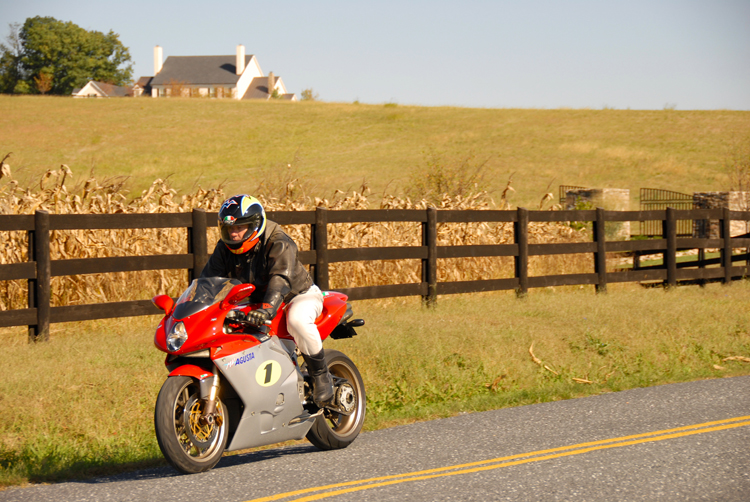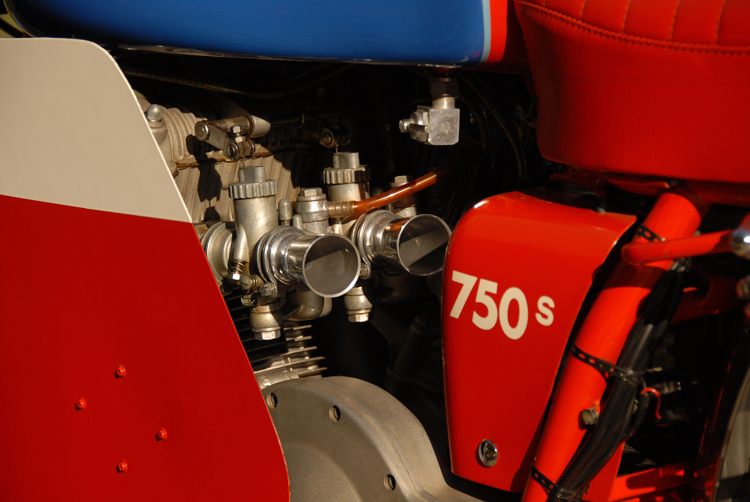Two August Agustas

Early morning light bathes the seductively shaped sculptures in warm radiance. Curvaceous bodywork, distinctively flared fuel tanks, brilliant red paint and the assertive thrust of those symmetric silencers denote great style and speed. The marque badges, with their iconic lettering, simply proclaim the obvious: MV Agusta.
Near the end of World War II, with Italy's defeat looming, it was eminently clear to Count Domenico Agusta that the days of producing military aircraft at his family's manufacturing facility near Milan were numbered. Italians would need affordable transportation after the war; and so the factory was converted in the war's last days to produce motor scooters and, later, motorcycles. The post-war financial success of this venture allowed the Count to indulge in the passions of his youth: motorcycles, mechanical engineering and motor sport.
Count Domenico oversaw all aspects of the Agusta racing program, including the selection of riders. During the 1960s and early 1970s, when his racing teams went head-to-head with the likes of Honda and Yamaha, Agusta established itself as perhaps the most highly successful motorcycle racing marque at the time.

The 1971 MV Agusta 750 S was the second street model offering the in-line four-cylinder engine developed in Agusta's racing program. A 600cc touring bike came out first with an in-line four, but there was such a loud enthusiasts' outcry for the 750 racing model that Count Dominico finally relented and allowed a limited production run of the 750 Sport. With its sexy styling and distinctively sculpted fuel tank, the 750 S is considered by many collectors to be one of the most beautiful motorcycles ever to put tires on the street.
However, the 750 S was a commercial failure in its day, resulting in a total production run of less than 700 bikes. Because the 750 S had a racing bike's complex design, it was not well-suited for low-cost mass production. Its substantially higher price tag constrained it from being competitive in a market offering similarly performing motorcycles for much less. Though not right for the times, a bike's low production numbers, beautiful styling, and an iconic racing marque often are just the right ingredients that create a highly collectible motorcycle several decades later. And in this case that's exactly what happened.

The popularity of motorcycle racing, particularly in Italy during the 1960s, hit new heights when a young rider named Giacomo Agostini joined the Agusta racing stable. His riding abilities and good looks drew many new fans (not the least of whom were throngs of attractive young women) to the dangerous and exciting sport of motorcycle road racing. The on-track battles between Giacomo "Ago" Agostini and Mike "The Bike" Hailwood, as teammates and later as competitors for different manufacturers, is the stuff of motorcycle racing legend.
Several decades later, rescued from the ashes and now owned by Cagiva, the reborn MV Agusta brand introduced a new, limited production motorcycle dedicated to the rider who brought Agusta its most prestigious championship victories: Giacomo Agostini. The F4-1000 "Ago" was first offered to motorcycle enthusiasts in 2004 as a limited, 300-bike production run that only reserved 60 of these instantly collectible motorcycles for export to the U.S.

The "Ago" has many of the same delicious Italian designs featured in the F4-750 introduced in 1997, but it also has many distinctive features of its own, including the 166hp, 1000cc engine, lightweight aluminum Marchesini wheels, numerous carbon-fiber body parts, a gold plaque on the steering head with the bike's serial number, a rev-counter with Giacomo Agostini's signature on it, the number 1 inside a yellow oval on the silver side panels, a certificate with an original Agostini signature, and many more collectible elements.
I caught up recently with noted collector Peter Calles, who owns both the very rare 1971 MV Agusta 750 S and a 2005 MV F4-1000 Ago (No. 106 of 300) in his large group of Italian motorcycles. Peter, on a collector's cloud nine, had just won best in show at AMA's 2007 Councours d'Elegance with his 1971 MV Agusta 750 S.
He told me how he came to own the rare 750 S MV Agusta. Although he had targeted the 1971 750 Sport Agusta, with its drum brakes, for his collection years ago, he says it took some time for him to locate one in the pristine condition collectors desire. After locating an excellent example in Canada, it took five years of on-again, off-again negotiations with the owner before the legendary Agusta was finally his. When the 750 S isn't on the show circuit, it resides in the living room of Peter's Bethesda, Maryland home.
A more recent addition to Peter's Italian motorcycle collection is a 2005 MV F4-1000 Ago in showroom condition, with only a couple thousand miles on it. When he fired up the engine of this beauty for me, the four exhausts played some of the loveliest mechanical music I've ever heard.
As Peter says, these two MV Agustas are like collectible bookends. The 1971 MV 750 S was the first Agusta street bike to sport a big, in-line, four-cylinder engine; and the F4 Ago sports the latest evolution of Agusta's legendary in-line fours. Representing the utmost in mechanical artistry, their beauty is awesome. And the sight of them together is so exceptional that all I can offer in reaction is an exuberant cliché - "Momma Mia!"











